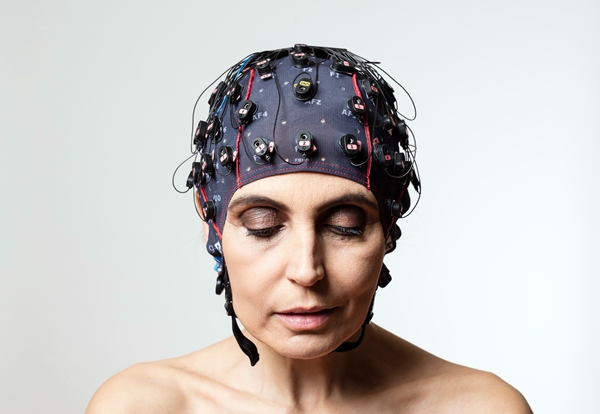13 June 2017. Tests of a device designed for people with consciousness disorders to provide basic feedback to questions show the system can elicit and capture responses from these individuals. A report of the findings of tests of the MindBeagle system conducted by its developer, Guger Technologies in Graz, Austria appear in the 5 May issue of the journal Frontiers in Neuroscience.
The MindBeagle system uses electroencephalogram or EEG signals in the brain and tactile stimulation on the skin to achieve limited communications with people having less than full consciousness, such as individuals recovering from a coma or in diseases like amyotrophic lateral sclerosis, or ALS, also known as Lou Gehrig’s disease. In these disorders, individuals lose functioning of their voluntary muscles, with at best only eye movements to indicate consciousness or respond to stimuli. The device is designed to determine if the individual can respond to clinicians’ questions, and provide a basic level of interaction.
With MindBeagle, the patient wears headgear resembling a swim cap with electrodes recording EEG signals in the brain, as well as wrist bands that vibrate. In some cases, a third vibration point is also applied to the back or shoulder. For assessments, EEG signals are first calibrated for each individual, then the wrist bands are stimulated with vibrations, with one band receiving 7 times more stimulation than the other. The patient is asked to count the number of times the lesser-stimulated wrist is vibrated. The third vibrator on the back or shoulder is a distracter, used in assessments of consciousness and functioning.
MindBeagle also works with motor imagery. In this mode, patients are asked to imagine lifting their left or right hands for a few seconds. The vibration test takes about 2.5 minutes, while the motor imagery test takes about 9 minutes. Software on an attached laptop captures and interprets the EEG signals for responses from the individuals.
In the study, the research team recruited 12 individuals with ALS at a hospital in Palermo, Italy to test the MindBeagle. The individuals had locked-in syndrome, where they lost all physical movements, including speech, but still had voluntary eye movements, as well as visual and auditory senses, while 3 of the participants had complete locked-in syndrome, including the loss of even voluntary eye movements. (The patients’ legal guardians or representatives gave consent to take part.) The team also recruited 3 healthy individuals to participate in the tests for comparison, and to ascertain the system was working properly.
The tests included assessments of consciousness, as well as responses to simple questions, all of which were completed in 20 minutes or less. The MindBeagle system was able to successfully assess the individuals’ consciousness levels more than 70 percent of the time, with 10 of the 12 participants. With answering questions, the 2 wrist bands mode was accurate on average about three-quarters of the time (77%), compared to 63 percent accuracy for the three vibration points — 2 wrist bands, plus the back or shoulder — and 58 percent for motor imagery mode. The researchers believe the longer time for the motor imagery tests, about 9 minutes, could have caused more fatigue than the shorter wrist band tests, taking 2.5 minutes.
In the following video, co-author Rossella Spataro, a neurologist with the ALS Clinical Research Center at University of Palermo, and the daughter of a patient taking part in the study tell more about the MindBeagle system.
- High-Resolution Surgical Brain Monitor Demonstrated
- Synthetic Retina Developed with Natural Materials
- Computer Vision, Deep Learning Aid Prosthetic Hands
- Neural Technology Research Centers Launched
- Sensors, Wearables Track Moods and Eating Behavior
* * *


 RSS - Posts
RSS - Posts
[…] Brain-Computer Device Tested with Consciousness Patients […]